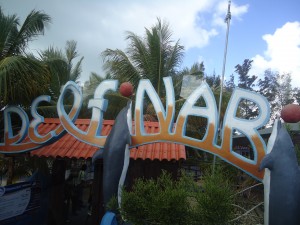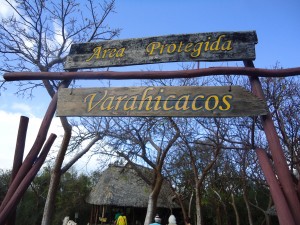The Other Side of the Delfinario
May 4, 2012 by admin
While most of us decided to explore the woods at Varahicacos ecological preserves in place of the dolphin show at the delfinario in Varadero, Cuba, I decided to be one of the 5 or 6 people to go explore it. I suppose numerous students decided not to go since they could not tolerate adorable creatures being held in captivity. Others did not go because they did not like the sanitary conditions in which the dolphins were held and so did not want to support it. Also, some were simply more interested in exploring the ecological preserves. Although these reasons might not reflect all the reasons why most of us opted-out of going to the dolphin show, they were still evident amongst the group. I was somewhat confused by the decision of some to not go since this was not the first time on our trip we observed or unintentionally participated in the unfair treatment of animals. For example, half of the class (including myself) took the horse-drawn carriage to one of our destinations.
OR
As a neuroscience & behavior student, I was drawn to learning about the behavior and cognitive abilities of the dolphins. Even though I do not support paying to see animals being held in captivity to amuse people with their tricks, I found this to be an enlightening experience. Since the tickets were already paid for, I didn’t think it made much difference whether or not I went. I had learned in books and science journals that dolphins were capable of higher cognitive abilities, but seeing it with my own eyes made me realize the high capacity of intelligence in these dolphins. Dolphins have been found to have a brain size much larger than humans when corrected for their body mass. This suggests their possession of complex cognitive functions. Some cognitive abilities found in dolphins include, self-awareness, problem-solving, and tool-use.
At the delfinario, through classical conditioning, hand gestures, and rewards, the dolphins had learned countless tricks (even better than humans) which included, jumping through hoops, playing basketball , singing, dancing to reggaethon music, ball tossing, and acrobatics. The dolphins seemed happy and content as they leaped up to hug, kiss, or shake hands with their trainers or to reach for their treat. They also seemed very healthy and energetic. Some of the dolphins had been at the delfinario since its inception, while others were pregnant and gave birth to their young at the delfinario. Some of the dolphins that were part of the show were Geelie, age 9, Cachita, age 19, and Christina “the superstar of the delfinario”, age 39. Christina was the most trained, intelligent, and the oldest dolphin at the delfinario. During the performance, the younger dolphins were being trained on one side of the platform and were also given treats for their hard work. Dolphins were not the only creatures that waited alongside the platform for their well-deserved treats, pelicans and seagulls also anticipated and were rewarded food treats for their patience.
Here is a video I took of the dolphins dancing to Reggaethon:
The bright side of the delfinario is that it sparks realization in others like it did in me about how intelligent dolphins are and raises awareness about the importance of conserving their environment. Also, since most of the dolphins were born at the delfinario they have become pretty comfortable performing in the fenced in mangrove lagoon. Individuals who do not support the captivity of the dolphins will be happy to know that money raised through the show is used to protect the dolphins and preserve their natural environment. Additionally, individuals will be somewhat pacified to know that the dolphins are kept in semi-captivity, in which case they are allowed the opportunity to swim out to sea. This condition is better than some delfinarios in America where the dolphins are kept in an unnatural environment of a tank. This semi-captivity may not cut it for some, for this reason, we might need Commandante Bernardo to take action in making a delfinario in Cuba where instead of dolphins being kept in captivity to entertain humans, individuals are transported out to sea to observe the dolphins perform in their natural environment. Also, you can support and protect the dolphins by signing the Declaration of Rights for Cetaceans on Zan’s post.
http://www.sciencedaily.com/releases/2010/02/100218173112.htm
http://www.comparativepsychology.org/ijcp-2010-3/08.Mercado_DeLong_FINAL.pdf
One Response to “The Other Side of the Delfinario”
Leave a Reply
You must be logged in to post a comment.



http://www.gloucestercarpetcleaning.com